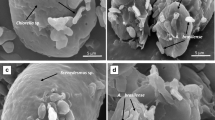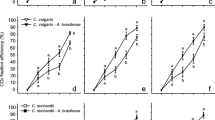Abstract
This study evaluated the ability of the bacterium Azospirillum brasilense to establish a synergic association with the microalgae Chlorella sp. and Scenedesmus sp. co-cultured in suspension and supplied with biogas (75% CH4–25% CO2). The results demonstrated that under the stressful composition of biogas, signal molecule production, such as indole-3-acetic acid (IAA) and tryptophan (Trp) production by the bacterium and microalgae, respectively, allowed the maintenance of their affinity and mutualistic association. Chlorella sp. and Scenedesmus sp. co-cultured in suspension with the bacterium showed higher CO2 fixation rates, 0.29 ± 0.05 and 0.31 ± 0.06 g·L−1·day−1, respectively, than cultured alone, 0.17 ± 0.04 and 0.22 ± 0.03 g·L−1·day−1. Similarly, biomass production of Chlorella sp. (1.4 ± 0.4 g·L−1) and Scenedesmus sp. (1.6 ± 0.5 g·L−1) and their cell composition—mainly carbohydrates and proteins—also enhanced in both microalgae interacting with the bacterium. Overall, these results indicate that, co-cultured in suspension, this consortium microalga–A. brasilense did not change its mutualistic interaction during the specific conditions of CO2 capture from biogas.






Similar content being viewed by others
References
Yong JJY, Chew KW, Khoo KS, Show PL, Chang JS (2021) Prospects and development of algal-bacterial biotechnology in environmental management and protection. Biotechnol Adv 47:107684. https://doi.org/10.1016/j.biotechadv.2020.107684
Rosero-Chasoy G, Rodríguez-Jasso RM, Aguilar CN, Buitrón G, Chairez I, Ruiz HA (2021) Microbial co-culturing strategies for the production high value compounds, a reliable framework towards sustainable biorefinery implementation – an overview. Bioresour Technol 321:124458. https://doi.org/10.1016/j.biortech.2020.124458
González-González LM, de-Bashan LE (2021) Toward the enhancement of microalgal metabolite production through microalgae–bacteria consortia. Biology 10:282. https://doi.org/10.3390/biology10040282
Ramanan R, Kim BH, Cho DH, Oh HM, Kim HS (2016) Algae-bacteria interactions: evolution, ecology and emerging applications. Biotechnol Adv 34:14–29. https://doi.org/10.1016/j.biotechadv.2015.12.003
Zhang B, Li W, Guo Y, Zhang Z, Shi W, Cui F, Lens PNL, Tay JH (2020) Microalgal-bacterial consortia: from interspecies interactions to biotechnological applications. Renew Sustain Energy Rev 118:109563. https://doi.org/10.1016/j.rser.2019.109563
Grossart H (1999) Interactions between marine bacteria and axenic diatoms (Cylindrotheca fusiformis, Nitzschia laevis, and Thalassiosira weissflogii) incubated under various conditions in the lab. Aquat Microb Ecol 19:1–11. https://doi.org/10.3354/ame019001
Ramos-Ibarra JR, Rubio-Ramírez TE, Mondragón-Cortez P, Torres-Velázquez JR, Choix FJ (2019) Azospirillum brasilense-microalga interaction increases growth and accumulation of cell compounds in Chlorella vulgaris and Tetradesmus obliquus cultured under nitrogen stress. J Appl Phycol 31:3465–3477. https://doi.org/10.1007/s10811-019-01862-1
Choix FJ, López-Cisneros CG, Méndez-Acosta HO (2018) Azospirillum brasilense increases CO2 fixation on microalgae Scenedesmus obliquus, Chlorella vulgaris, and Chlamydomonas reinhardtii cultured on high CO2 concentrations. Microb Ecol 76:430–442. https://doi.org/10.1007/s00248-017-1139-z
de-Bashan LE, Mayali X, Bebout BM, Weber PK, Detweiler AM, Hernandez JP, Prufert-Bebout L, Bashan Y (2016) Establishment of stable synthetic mutualism without co-evolution between microalgae and bacteria demonstrated by mutual transfer of metabolites (NanoSIMS isotopic imaging) and persistent physical association (Fluorescent in situ hybridization). Algal Res 15:179–186. https://doi.org/10.1016/j.algal.2016.02.019
Palacios OA, Gomez-Anduro G, Bashan Y, de-Bashan LE (2016) Tryptophan, thiamine and indole-3-acetic acid exchange between Chlorella sorokiniana and the plant growth-promoting bacterium Azospirillum brasilense. FEMS Microbiol Ecol 92:1–11. https://doi.org/10.1093/femsec/fiw077
Ruiz-Güereca S-S, Sánchez-Saavedra MP (2016) Growth and phosphorus removal by Synechococcus elongatus co-immobilized in alginate beads with Azospirillum brasilense. J Appl Phycol 28:1501–1507. https://doi.org/10.1007/s10811-015-0728-9
Nagarajan D, Lee DJ, Chang JS (2019) Integration of anaerobic digestion and microalgal cultivation for digestate bioremediation and biogas upgrading. Bioresour Technol 290:121804. https://doi.org/10.1016/j.biortech.2019.121804
Kapoore RV, Padmaperuma G, Maneein S, Vaidyanathan S (2021) Co-culturing microbial consortia: approaches for applications in biomanufacturing and bioprocessing. Crit Rev Biotechnol 1–37.https://doi.org/10.1080/07388551.2021.1921691
Smith DL, Johnson KB, Darmstadt TU (1996) A guide to marine coastal plankton and marine invertebrate larvae. Kendall/ Hunt Publishing Company, Iowa
Choix FJ, Polster E, Corona-González RI, Snell-Castro R, Méndez-Acosta HO (2017) Nutrient composition of culture media induces different patterns of CO2 fixation from biogas and biomass production by the microalga Scenedesmus obliquus U169. Bioprocess Biosyst Eng 40:1733–1742. https://doi.org/10.1007/s00449-017-1828-5
de-Bashan LE, Schmid M, Rothballer M, Hartmann A, Bashan Y (2011) Cell-cell interaction in the eukaryote-prokaryote model of the microalgae Chlorella vulgaris and the bacterium Azospirillum brasilense immobilized in polymer beads. J Phycol 47:1350–1359. https://doi.org/10.1111/j.1529-8817.2011.01062.x
Vega BOA, Lovina DV (2017) Métodos y herramientas analíticas en la evaluación de la biomasa microalgal. CIBNOR, México
Chisti Y (2007) Biodiesel from microalgae. Biotechnol Adv 25:294–306. https://doi.org/10.1016/j.biotechadv.2007.02.001
Dubois M, Gilles KA, Hamilton JK, Rebers PA, Smith F (1956) Colorimetric method for determination of sugars and related substances. Anal Chem 28:350–356
Lowry OH, Rosebrough NJ, Farr AL, Randall RJ (1951) Protein measurement with the folin phenol reagent. J Biol Chem 193:265–275
Bligh EG, Dyer WJ (1959) A rapid method of total lipid extraction and purification. Can J Biochem 37:911–917
Guldhe A, Ansari FA, Singh P, Bux F (2017) Heterotrophic cultivation of microalgae using aquaculture wastewater: a biorefinery concept for biomass production and nutrient remediation. Ecol Eng 99:47–53. https://doi.org/10.1016/j.ecoleng.2016.11.013
Pistorius AMA, DeGrip WJ, Egorova-Zachernyuk TA (2009) Monitoring of biomass composition from microbiological sources by means of FT-IR spectroscopy. Biotechnol Bioeng 103:123–129. https://doi.org/10.1002/bit.22220
Stuart BH (2004) Infrared spectroscopy: fundamentals and applications. Wiley, Canada
Ganusova EE, Vo LT, Mukherjee T, Alexandre G (2021) Multiple CheY Proteins Control Surface-Associated Lifestyles of Azospirillum brasilense. Front Microbiol 12:900. https://doi.org/10.3389/fmicb.2021.664826
Duca DR, Glick BR (2020) Indole-3-acetic acid biosynthesis and its regulation in plant-associated bacteria. Appl Microbiol Biotechnol 104:8607–8619. https://doi.org/10.1007/s00253-020-10869-5
Pagnussat LA, Maroniche G, Curatti L, Creus C (2020) Auxin-dependent alleviation of oxidative stress and growth promotion of Scenedesmus obliquus C1S by Azospirillum brasilense. Algal Res 47:101839. https://doi.org/10.1016/j.algal.2020.101839
Peng H, de-Bashan LE, Bashan Y, Higgins BT (2020) Indole-3-acetic acid from Azosprillum brasilense promotes growth in green algae at the expense of energy storage products. Algal Res 47:101845. https://doi.org/10.1016/j.algal.2020.101845
Peng H, de-Bashan LE, Higgins BT (2021) Comparison of algae growth and symbiotic mechanisms in the presence of plant growth promoting bacteria and non-plant growth promoting bacteria. Algal Res 53:102156. https://doi.org/10.1016/j.algal.2020.102156
Peng H, de-Bashan LE, Higgins BT (2021) Azospirillum brasilense reduces oxidative stress in the green microalgae Chlorella sorokiniana under different stressors. J Biotechnol 325:179–185. https://doi.org/10.1016/j.jbiotec.2020.10.029
Bashan Y, de-Bashan LE (2010) How the plant growth-promoting bacterium Azospirillum promotes plant growth-a critical assessment. Adv Agron 108:77–136
Malhotra M, Srivastava S (2009) Stress-responsive indole-3-acetic acid biosynthesis by Azospirillum brasilense SM and its ability to modulate plant growth. Eur J Soil Biol 45:73–80. https://doi.org/10.1016/j.ejsobi.2008.05.006
Ona O, Van Impe J, Prinsen E, Vanderleyden J (2005) Growth and indole-3-acetic acid biosynthesis of Azospirillum brasilense Sp245 is environmentally controlled. FEMS Microbiol Lett 246:125–132. https://doi.org/10.1016/j.femsle.2005.03.048
Okon Y, Bar T, Tal S, Zaddy E (1991) Physiological properties of Azospirillum brasilense involved in root growth promotion. In: Polsnielli M, Naterassi R, Vincenzini M (eds) Nitrogen fixation. Kluwer academic publishers, Norwell, pp 113–125
Mohanty S, Swain CK (2018) Role of microbes in climate smart agriculture. In: Panpatte DG, Jhala YK, Shelat HN, Vyas RV (eds) Microorganisms for green revolution. Springer, Singapore, pp 129–140
Bhattacharya M, Goswami S (2020) Microalgae – a green multi-product biorefinery for future industrial prospects. Biocatal Agric Biotechnol 25:101580. https://doi.org/10.1016/j.bcab.2020.101580
Li Y, Han D, Sommerfeld M, Hu Q (2011) Photosynthetic carbon partitioning and lipid production in the oleaginous microalga Pseudochlorococcum sp. (Chlorophyceae) under nitrogen-limited conditions. Bioresour Technol 102:123–129. https://doi.org/10.1016/j.biortech.2010.06.036
Choix FJ, Bashan Y, Mendoza A, de-Bashan LE (2014) Enhanced activity of ADP glucose pyrophosphorylase and formation of starch induced by Azospirillum brasilense in Chlorella vulgaris. J Biotechnol 177:22–34. https://doi.org/10.1016/j.jbiotec.2014.02.014
Li T, Yang F, Xu J, Wu H, Mo J, Dai L, Xiang W (2020) Evaluating differences in growth, photosynthetic efficiency, and transcriptome of Asterarcys sp. SCS-1881 under autotrophic, mixotrophic, and heterotrophic culturing conditions. Algal Res 45:101753. https://doi.org/10.1016/j.algal.2019.101753
Rodas-Zuluaga LI, Castañeda-Hernández L, Castillo-Vacas EI, Gradiz-Menjivar A, López-Pacheco IY, Castillo-Zacarías C, Boully L, Iqbal HMN, Parra-Saldívar R (2021) Bio-capture and influence of CO2 on the growth rate and biomass composition of the microalgae Botryococcus braunii and Scenedesmus sp. J Co2 Util 43:101371. https://doi.org/10.1016/j.jcou.2020.101371
Acknowledgements
Francisco J. Choix acknowledges the Consejo Nacional de Ciencia y Tecnología (CONACyT, Mexico) for the support under the Program-Project 90 Cátedras CONACyT and Martín Flores Martínez and Sergio Oliva León for scanning electron microscopy (SEM) service of CUCEI-UdG; to Diana Fischer for English edition.
Funding
This study was funded by the CONACyT- Frontiers of Science 2019 Project 15769.
Author information
Authors and Affiliations
Contributions
Barbosa-Nuñez J.A.: investigation and formal analysis. Oskar Palacios: writing — original draft, development, or design of methodology. Mondragón-Cortez P.: investigation, visualization, and formal analysis. Ocampo-Álvarez H. and Becerril-Espinosa A.: visualization, data curation, and formal analysis. Nevárez-Moorillón G.V.: data curation and writing — review and editing. Francisco Choix: writing — original draft, funding acquisition, project administration, and conceptualization.
Corresponding author
Ethics declarations
Ethical Approval
This article does not contain any studies with human participants or animals performed by any of the authors.
Conflict of Interest
The authors declare no competing interests.
Additional information
Publisher’s Note
Springer Nature remains neutral with regard to jurisdictional claims in published maps and institutional affiliations.
Supplementary Information
Below is the link to the electronic supplementary material.
12155_2022_10411_MOESM1_ESM.pdf
Supplementary file 1. Qualitative biomass characterization and dissolved inorganic carbon uptake of A. brasilense cultured in suspension or immobilized in alginate beads under biogas. (PDF 262 KB)
Rights and permissions
About this article
Cite this article
Barbosa-Nuñez, J.A., Palacios, O.A., Mondragón-Cortez, P. et al. Chemical and Physical Affinity of Microalga–Azospirillum Consortium Co-cultured in Suspension During CO2 Fixation from Biogas. Bioenerg. Res. 16, 579–592 (2023). https://doi.org/10.1007/s12155-022-10411-7
Received:
Accepted:
Published:
Issue Date:
DOI: https://doi.org/10.1007/s12155-022-10411-7




